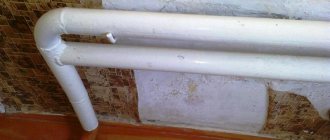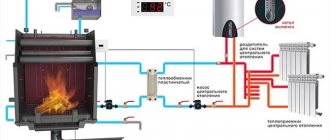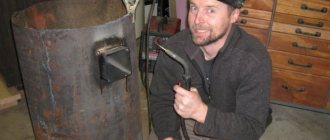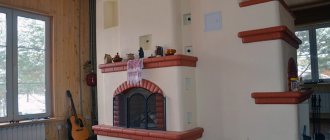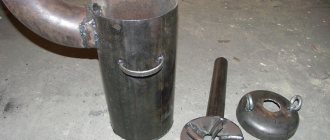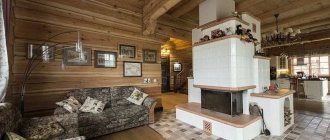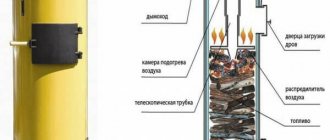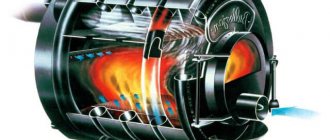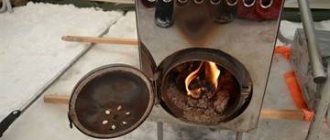Despite the general gasification, there are still many places where you cannot do without a good wood stove. In addition, rising gas prices sometimes pose insurmountable financial challenges to homeowners. Finding alternative heating methods and upgrading existing ones often solve problems that arise in the most unexpected way. Thus, a water stove can save up to 50% of fuel and makes you look at classic home heating in a new way.
A water stove will help reduce fuel consumption and save a lot of money
The essence of the invention:
If moist cold air (a mixture of gases that we breathe) is passed through a Pocheevsky hydrogen cell, and then passed through a heterogeneous catalyst, which is the coals of a firewood, the air ignites with a large release of heat.
The efficiency of the above process depends on the vapor concentration, the speed of movement of molecules through temperature zones, the temperature of these zones, the length of the zones, as well as catalytic factors.
Superheated water vapor with hydrogen passes through burning coals, which act as a catalyst for the formation of water gas. When ignited, it partially goes into a combustion mode similar to the combustion of a wax candle, where the role of wax is played by superheated water vapor, and the coals of burning wood are the wick. The combustible gas mixture obtained by the decomposition of water vapor H2O with hot coal C has the following, to the utmost degree of purity, composition: by volume 50% hydrogen and 50% carbon monoxide, by weight - 6% hydrogen and 94% carbon monoxide. Usually water gas does not have this composition; it contains, in addition to the named components, an admixture of carbonic acid, nitrogen and swamp gas.
The composition of water gas varies depending on the method of its production and the source fuel. The fact of obtaining flammable gas through the decomposition of water vapor with hot coal was discovered by the Italian scientist, Professor Felicius Fontana, who lived in 1730-1805. Despite the age of discovery, water gas has only in the last 15-20 years, mainly in the USA, become widespread both for lighting and for technical purposes.
Let's consider the physical and chemical properties of water gas, due to which it disputes its advantage over other types of gaseous fuels: coal (lighting) and generator gases. When water vapor passes through the hot coals of firewood, it decomposes, forming hydrogen, carbon monoxide and carbonic acid. The amount of the latter depends on the temperature at which the process occurs: at t=500°C the steam decomposes into hydrogen and carbon dioxide, and at t=1000-1200°C into hydrogen and carbon monoxide. Although the gas mixture of water gas contains small amounts of carbonic acid and nitrogen, its distinctive qualities are due to two main components: hydrogen and carbon monoxide. Therefore, when determining the heating capacity of water gas and the number of possible units of heat (calorie content), one must keep in mind the amount of heat released during the combustion of gas - the transition of hydrogen into water and carbon monoxide into carbonic acid.
The consumption of the heat of combustion of fuel (carbon) for the formation of water gas according to Naumann is about 8%. Based on this, it is believed that with water gas the thermal capacity of carbon is realized in the most advantageous way. This opinion is disputed by Lunge, who believes that the efficiency of burning water gas should be compared not with the combustion of coal in a furnace, but with generator gas, which, before being used in a hot state, is supplied from the generator to the combustion site. Under such conditions, generator gas, according to Lunge, represents a more advantageous implementation of the thermal capacity of carbon than water gas. A comparison of water gas with others in terms of combustion temperatures shows the following: for coal (lighting) gas t=2700°C; for generator gas t=2350°C; for water gas t=2859°C; for hydrogen t=2669°C; for carbon monoxide t=3041°C.
As you can see, the thermal effect produced by water gas with a small amount of hydrogen is more significant than that from generator gas heated to a high temperature because In regenerative fireboxes, the combustion air for gaseous fuels is heated by part of the heat removed from the firebox. In addition, the water gas flame is much more compact; The platinum wire melts in it, the magnesium body is highly heated, emitting a bright white light, which cannot be achieved either by coal (lighting) gas, burning it in a Bunsen burner, or by generator gas. The flame of a water gas, in comparison with a flame of a lighting gas, has almost 6 times less surface area with equal volumes of escaping gases, as a result of which it is cooled by radiation very slightly. These properties of water gas make it an advantageous and convenient source of heat.
Material of manufacture
Copper. Due to its ductility, copper is most optimal for the manufacture of a heat exchanger. A copper tube is easy to bend and give any shape. It has a high thermal conductivity coefficient - more than 380. But copper is also not a heat-resistant material and is expensive. Stainless steel. Also quite flexible and responsive material. Although it has a lower thermal conductivity coefficient. But it is resistant to temperature changes. You can weld any configuration from it
IMPORTANT: Galvanized steel cannot be used; when heated, it releases toxic zinc compounds into the air. Metal-plastic. Easily available practical material
Easily found, but it has a low thermal conductivity! Almost two orders of magnitude lower than that of copper. But this material is durable and resistant to temperature changes.
Conclusion.
Pocheevsky's hydrogen cell, in fact, is a generator for producing a combustible mixture (water gas) from ordinary water vapor contained in the air. Using it, you will burn a much smaller amount of fuel and at the same time receive more thermal energy, while at the same time extending the burning life of the fireplace.
This invention was preceded by testing of various “Miracle Membranes” invented by Vladimir Pocheevsky.
Report at the X International Conference “New Ideas in Geosciences”.
Extending the combustion of wood using the heterogeneous catalyst “Miracle Membranes”. V.N. Pocheevsky. RGGRU, Moscow, Russia.
Regional association of state security veterans "EFA - VIMPEL".
Searchers, geological explorers, polar explorers, military personnel, hunters, and cattle breeders, when working in the field, often have to light fires and light a stove for heating and cooking, both during the day and at night. There is not enough firewood for long-term burning. In order for the fire to burn for a long time and evenly under different weather conditions, consuming much less firewood, the authors invented a heterogeneous catalyst “Miracle Membrane”. The principle of its operation is as follows... - READ MORE...
| After many years of testing “The Miracle of Membranes”, we came to the conclusion that the membranes begin to work only when the furnace firebox is very hot, providing additional heat. “Miracle membranes” perfectly provide additional heat in iron stoves for baths and in stoves for heating water in trains and so-called “potbelly stoves” for country houses. In long-burning furnaces, they are ineffective, since when coals smolder, there is not enough temperature to ignite water gas. The Pocheevsky hydrogen cell is suitable for any furnace and any type of fuel. By making it and installing it in the furnace using our technology, you will get real fuel savings of more than 50% and an increase in the smoldering temperature of the coals! |
Building a boiler with your own hands
When working with metal, it is important to follow simple safety rules.
Project selection
For a home craftsman, a real challenge will be to independently manufacture a “Buleryan” type heater, but with patience and metal welding skills, this task is doable.
To create a device for heating water, you will need a square profile pipe with a wall thickness of 4 mm. During work, a welding machine, grinder, clamps and other metalworking equipment are used.
In addition to the square pipe, you will need several sheets of iron for the second chamber and doors, a valve, a pipe for the expansion tank, plumbing threads for the outlet and input of coolant.
The procedure for welding a hot water stove using wood
First of all, the collectors are welded: lower and upper. The lower one has the shape of a “box”, the entire structure will stand on it, the upper one is of any shape and serves as an expansion tank.
The heat exchanger consists of L-shaped square or round pipes bent in the form of a clamp. Their bottom is connected to the manifold, the top to the expansion tank. The gaps between the pipes are welded tightly with sheet metal.
A secondary combustion chamber is installed at 2-3 heights of the resulting tunnel. Hot gases rise along the hot shelf. It is better to make it from metal 5-7 mm thick; air ducts are connected to the beginning of the shelf.
A grate is installed at the bottom of the firebox.
The ends of the tunnel are welded, a chimney is mounted on the back wall, and doors and an ash pan are hung on the front side.
It is convenient to make the ash pan in the form of a removable scoop: this makes it easier to clean the stove.
The legs are welded, handles and wheels are attached - the stove can be transported like a wheelbarrow.
The stove is ready, now you can connect the chimney, fill the system with water and do a test run.
Heat exchanger
Various materials are used for furnaces with hot water boilers:
- Low-carbon steel, in the form of a coil of pipes with a diameter of 4 to 5 cm (or an assembly of steel sheet up to 0.5 cm thick);
- Cast iron, use old batteries from it, preferably compact in size (under the firebox);
- Copper (more expensive option).
A device made of steel tubes is more efficient to use, but more difficult to manufacture. The disadvantage of cast iron products is that they are difficult to clean from soot accumulation (the ribs get in the way). Copper cameras are rarely used, difficult for the owner to assemble and expensive to purchase.
Speaking of which. The heat exchanger significantly reduces the usable area of the firebox. There should be a gap between them - up to 15 mm (for products made of sheet steel - up to 10 mm).
Work order
You can make the equipment yourself or buy a factory unit.
When performing a silent installation, it is important to consider the following points:
- First prepare the heat exchanger;
- Then a circuit connected to the heat boiler is installed;
- Before erecting the furnace, a foundation pit is dug, then an intermediate layer of crushed stone and broken brick is made (the foundation should be 2-3 cm higher than the floor level);
- construction of the combustion facility continues.
What is important to do before warming up the chimney and pre-firing?
It is extremely important to remember that at the end and beginning of each heating season, regardless of the time of year, a preventive inspection and cleaning of the smoke duct should be carried out. During the period of non-use of the heating device, two things can happen to the chimney:
- Various debris from the street can get into the pipe - branches, bird or insect nests, leaves, pine needles, etc. The possibility of debris entering the pipe is especially high in cases where its head is not equipped with a deflector. Debris inside the smoke duct can clog it and prevent the free passage of smoke from the fireplace to the street, as well as stop the draft. The inability of flue gases to escape into the street will provoke their release into the premises, creating a situation dangerous to the health of residents. However, debris in the chimney can easily ignite and cause a fire in the chimney or, in the worst case, in the house.
- Build-ups of soot and condensation on the inner walls of the pipe can also hinder the free passage of smoke masses and draft. To eliminate risks when lighting a heating device after a long period of inactivity, experts recommend conducting a routine inspection of the pipe and, if necessary, cleaning the chimney. These actions can be carried out independently, but it is better with the help of professionals. A chimney cleaning service ordered from a specialized company will be performed efficiently and in compliance with all required, established fire and technical safety standards. At the same time, reliable quality guarantees are always provided for services of this type, ordered from trusted contractors.
Foundation for the building
Before building a stove, you need to lay the foundation for the future structure. The work is carried out in stages:
- First you need to dig a pit. Depth 45-50 cm.
- Sand is poured onto the bottom and compacted thoroughly. The layer thickness is 8-10 cm. A layer of crushed stone is placed on top.
- Next, you should install the reinforcing grid and fill it with cement mortar. The mixture contains crushed stone, sand and cement in a ratio of 1:2:1. The pit is filled to one third.
- Then the second layer is poured. The solution is represented by sand and cement (3:1). It should be filled in such a way that 5 cm remains to the top of the pit. A second mesh with a cell size of 7x8 cm is also placed here.
- Pour the last third layer of cement mortar and level it with the rule. The structure is covered with a polyethylene film.
The concrete will cure within 30 days. To make it stronger, experts recommend moistening it every day. At the end, the foundation is lined with strips of roofing felt.
Pros and cons of a stove with a water heating circuit
Heating a house from a wood stove is a common phenomenon in Russian villages and villages. However, a conventional stove can heat only one, or maximum two rooms. At the same time, residents of rural areas do not seek to replace the traditional Russian brick or stone stove with a modern boiler, but instead, if possible, try to equip it with a water circuit.
Stove water heating is a virtually fail-safe system, reliable and affordable. The fuel for the stove is chopped wood (usually birch), coal, and peat briquettes. Cardboard, wood chips, waste from the woodworking and paper industries are also suitable for the firebox.
pros
The undoubted advantages of water heating from a stove include:
- low cost of the system;
- dependence solely on the availability of fuel;
- ease of use;
- long-lasting heat dissipation;
- use of several types of solid fuel.
If gas supply is not possible, a heating furnace with a water circuit is the best option.
Flaws
The main disadvantages of heating from a wood-burning stove with a water circuit are the long warm-up period before heat transfer begins, the difficulty of regulating heat transfer in individual rooms, the loss of some heat through the pipe, and the inability to automate the process.
In addition, a wood- and coal-fired stove requires particularly careful attention from a fire safety point of view: if used incorrectly, the risk of a fire in a residential building increases.
Types of furnaces with a water circuit
Ovens are made of brick (stone) or finished metal products are purchased. A brick stove with a water circuit weighs 1.5 tons or more, and the foundation, accordingly, must be built taking into account the significant weight of the structure. If you decide to install a brick structure, you will have to pour concrete into the foundation.
A metal stove similar to a potbelly stove is allowed to be placed in houses directly on a wooden floor. Since the weight of such a stove usually does not exceed 250-300 kg, there is no need to specially strengthen the foundation: it is enough to use reinforced floor joists.
Although a brick oven takes longer to heat up, it retains heat better. A steel installation heats up much faster, but also cools down quickly as soon as the fuel burns out.
Do you need electricity?
The system can be implemented in two versions:
- Free circulation when heated by gravity;
- Forced method.
In the latter case, you will need a pump and a battery (to ensure uninterrupted power supply). At first glance, this is convenient - it maintains stability. You can heat not only the first floor, but also other floors.
However, such components significantly increase the cost of heating the furnace, and the design itself acquires impressive dimensions.
